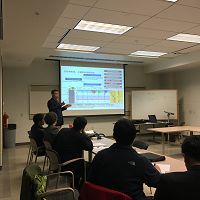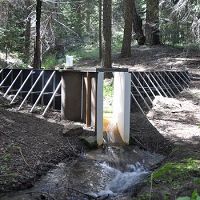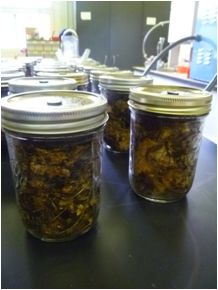Research Community
PSU Geosciences grad students Beth Herndon and Ashlee Dere work with Princeton geochemist Anne Krapiel (photo) to sample and analyze the chemistry of vegetation samples that are being archived for later sharing. Krapiel’s work, funded by NSF, targets analysis of Mo and V usage in enzymes in the watershed.
A variety of collaborative efforts are underway at SSHCZO including researchers affiliated with the Shale Transect satellite sites as well as colleagues from other institutions not directly affiliated with SSHCZO. A summary of some of the colleagues and their research is listed in the table below. Detailed descriptions of two collaborative research efforts are described here, including phenological research using a high resolution camera and work on nitrogen cycling.
| Name | Institution | Research |
|---|---|---|
| Mezimir Wagaw^* | Alabama A&M Univ. | Soil on shale in Alabama |
| Rob Jacob^ | Bucknell Univ. | Gravity measurements |
| Brian Reynolds^* | CEH, Wales | Soil on shale in Wales |
| Rich April^* | Colgate Univ. | Soil development on shale till |
| Jed Sparks^ | Cornell Univ. | Sr and Si cycling |
| Lou Derry^ | Cornell Univ. | Sr and Si cycling |
| Andrew Richardson^ | Harvard Univ. | Phenocam |
| Ryan Mathur^* | Juniata College | Soil on Marcellus shale |
| Taylor Perron^ | MIT | Fractures, fluid flow and topography |
| Anne Krapiel^ | Princeton Univ. | Mo cycling |
| Karen Salvage | SUNY Binghamton | Hydrogeological modeling |
| Laura Toran | Temple Univ. | Hydrogeophysics |
| Fangzhen Teng^ | Univ. of Arkansas | Mg isotopes at Shale Hills |
| Diana Karwan^ | Univ. of Delaware | sediment transport, Cs and Pb isotopes |
| Tom Johnson^* | Univ. of Puerto Rico | Soil development on shale |
| Chris Fedo^* | Univ. of Tennessee | Soil on shale in Tennessee |
| Paul Biermann^ | Univ of Vermont | Cosmogenic isotopes |
| Lin Ma^ | Univ. of Texas, El Paso | REE in shale transect sites |
| Lixin Jin^ | Univ. of Texas, El Paso | C isotopes at Shale Hills |
| David Woodruff^ | USDA-Forest Service | Sap flux and tree water relations |
| Frederick Meinzer^ | USDA-Forest Service | Sap flux and tree water relations |
| Elisabeth Knapp^* | Washington & Lee Univ. | Soil on shale in Virginia |
| Beth Boyer^ | Penn State Univ. | DOC, precipitation monitoring |
| Mary Ann Bruns^ | Penn State Univ. | Soil microbiology |
| Rudy Slingerland | Penn State Univ. | Sediment transport, tree throw |
| Maureen Feineman^ | Penn State Univ. | Li isotopes at Shale Hills |
| Matt Fantle^ | Penn State Univ. | Ca isotopes at Shale Hills |
| Margot Kaye^ | Penn State Univ. | Assessment of litterfall |
| David Pollard^ | Penn State Univ. | Climate modeling for transect |
| Tim White | Penn State Univ. | Transect |
Phenology
Dr. Andrew Richardson (Harvard University) has recently provided a high resolution video camera (StarDot NetCam SC Megapixel Hybrid IP Camera) that we have mounted at the eddy flux tower at the Shale Hills CZO. This camera monitors changes in phenology (e.g. leaf emergence and fall leaf senescence) and snow cover with greater temporal resolution than is logistically feasible for individual observers. This camera also helps support a PSU student-initiated project to monitor phenology in central PA (PennPhen, www.sites.google.com/site/psuphenology), contributes data to a larger network of camera based phenology observations (http://phenocam.sr.unh.edu/), and provides data that supports ongoing projects at the CZO.
Nitrogen fixation
Dr. Anne Kraepiel from Princeton University has been using the Shale Hills watershed to work on the NSF-funded project, “Acquisition of nitrogenase metal cofactors in soils: role of metallophores and limitation of N2-fixation.” In September 2011 and July 2012, Anne traveled to SSHO to conduct experiments with co-PI Sue Brantley and graduate student Ashlee Dere. Organic layer samples were collected at three valley floor sites within the watershed and incubated in the laboratory to determine nitrogen fixation rates and mechanisms in the watershed. Nitrogen fixation activity was determined by incubating the samples with acetylene for 8 hrs and measuring the production of ethylene over time using the GC at Princeton University. Preliminary results suggest that nitrogen fixation rates are not measurable in the fall and low in the summer months. The experiment will be repeated in July 2013 at SSHO CZO and at the Christina River Basin CZO.
Samples were collected at three valley floor sites within the watershed and incubated in the laboratory to determine nitrogen fixation rates.
Samples were collected at three valley floor sites within the watershed and incubated in the laboratory to determine nitrogen fixation rates.
Nitrogen fixation activity was determined by incubating the samples with acetylene for 8 hrs and measuring the production of ethylene over time using the GC at Princeton University.
News

Catchment characteristics to be modeled by Laura Clemente-Harding, PhD student Geography
19 Jun 2018 - Over three days in the Shale Hills catchment, Clemente-Harding along with her colleagues at the Geospatial Research Laboratory Engineer Research and...

Dr. Ying Fan Reinfelder visits for the 2018 All-Hands Meeting at Penn State
10 May 2018 - Over the course of two days each May, the SSHCZO comes together for the annual All-Hands science meeting at Penn State. This year, Dr. Ying...

Discussion paper open till April 5th in Biogeosciences
06 Mar 2018 - A discussion is open for the manuscript, "Elevating the biogeosciences within environmental research networks".

Delegation from China Geologic Survey visits Shale Hills CZO
03 Nov 2017 - During the week of October 30th, Penn State and SSHCZO hosted 15 scientists from the China Geological Survey, with interests ranging from saltwater...

Water Resources Research Special Collection: Concentration-discharge relations in the critical zone
30 Oct 2017 - Water Resources Research published a new special collection in September 2017 featuring concentration-discharge research from multiple CZOs.
Explore Further



